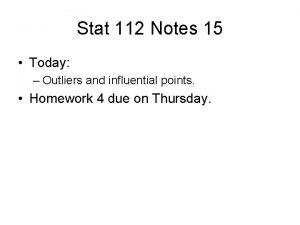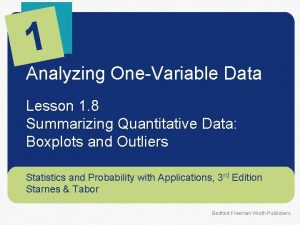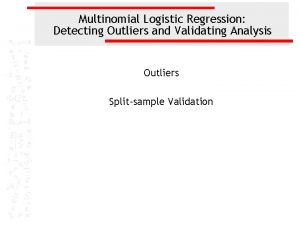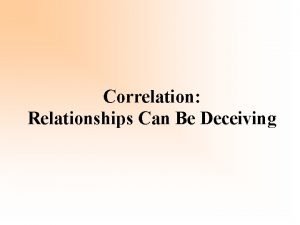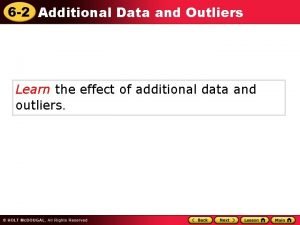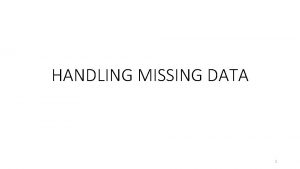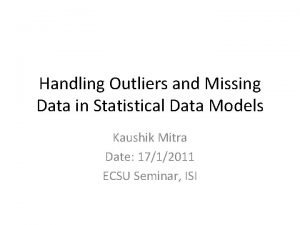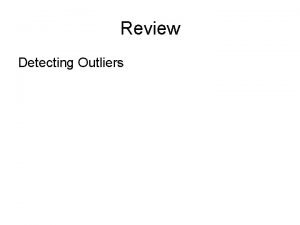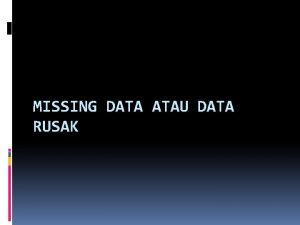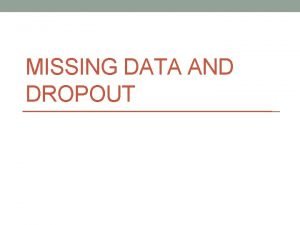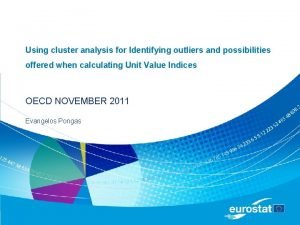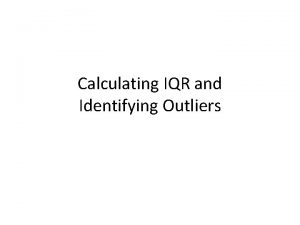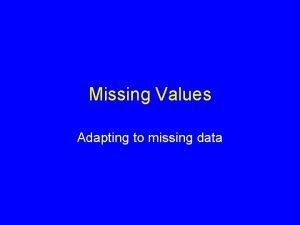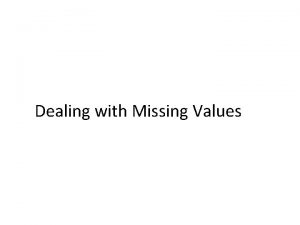Strategies for Identifying Outliers and Managing Missing Data




















- Slides: 20

Strategies for Identifying Outliers and Managing Missing Data R. Michael Haynes, Ph. D rhaynes@tarleton. edu Tarleton State University A PRIORI MARCH 1, 2012 Assistant Vice President for Student Life Studies POST HOC FEBRUARY 29, 2012 Executive Director of Institutional Research Assistant Professor Educational Leadership and Policy Studies

A little background. . . Outlier analysis in multiple regression class Data inspection (missing data) was a key aspect of dissertation Try to incorporate at the very least “a nod” to data inspection in any assessment/project completed

Why is it important to evaluate your data set? Can help in…. . Identifying input errors Indentifying spurious data points (an answer of “ 6” on a 1 -5 Likert scale) Makes your findings more sound Good practice as recommended by the American Psychological Association (Wilkerson & APA Task Force on Statistical Inference, 1999)

Desired Outcomes Knowledge of various data inspection methods visual range of data set Methods for managing missing data list wise deletion pair wise deletion mean replacement linear trend point Criteria for identifying outliers/spurious data points standardized residuals/predicted values standard deviation diagnostics Cook’s D values

Data inspection methods Visual Can alert you to missing cases Most beneficial with smaller datasets where review of individual cases is possible

Data inspection methods SPSS minimum/maximum values function Quick method of inspecting range of larger data sets Descriptive Statistics N Minimum Maximum Mean Std. Deviation Learning Community 884 0 1 . 14 . 343 You are taking this survey: 874 1 3 2. 01 . 139 Recoded response to high 883 1 4 3. 94 . 367 school graduation year variable HGRADYR Valid N (listwise) 873

What to do about missing values? SPSS options Exclude cases listwise: Only cases with valid values for all variables are included in the analyses. Exclude cases pairwise: Cases with complete data for the pair of variables being correlated are used to compute the correlation coefficient on which the regression analysis is based. Degrees of freedom are based on the minimum pairwise N Replace with mean: All cases are used for computations, with the mean of the variable substituted for missing observations (SPSS Inc. , 233 S. Wacker Drive, Chicago, IL, 60606)

Problems with these options… Listwise excludes all values for a case missing even 1 variable value…throws the baby out with the bath water! Pairwise only utilizes variables for which both values are present Can lead to distortion of findings through selection bias (King, Honeker, Joseph, & Scheve, 1998)

More preferred options… Choose “Transform” -> “Missing Values” Enter variables with missing values into “New Variable” box Under “Name and Method”, select one of the following: Series Mean of Nearby Points Median of Nearby Points Linear Interpolation Linear Trend at Point I prefer the last option, Linear Trend at Point

Linear Trend at Point Uses theory of regression to calculate coefficients based upon existing values Generates a replacement value for each case on each variable More robust than simply replacing with mean

Identifying outliers… what is an outlier? An unusual score in a distribution that is considered extreme and may warrant special consideration (Hinkle, Wiersma, & Jurs, 2003). . . a data point distinct or deviant from the rest of the data (Pedhazur, 1997)

Why is it important to identify potential outliers? Can skew findings which in turn can skew conclusions/decisions/programming Can help identify case in dire need of additional programming/resources…. . finding that lost raft at sea! As mentioned earlier, can assist in identifying data entry errors

Strategies for identifying outliers in your dataset Standardized predicted and residual scores

Strategies for identifying outliers in your dataset

Strategies for identifying outliers in your dataset Residuals 3 standard deviations away from mean Rule of thumb…. ” 99% of your dataset should fall within + or – 3 standard deviations from the mean” Casewise Diagnosticsa Case Number Percent Hispanic Std. Residual Enrollment Predicted Value Residual 75 -4. 091 . 180 . 54883 -. 368829 88 -3. 195 . 020 . 30811 -. 288109 175 -4. 068 . 060 . 42682 -. 366818 a. Dependent Variable: Percent Hispanic Enrollment

Strategies for identifying outliers in your dataset Cook’s D values Considers each variables relationship to the other variables in the dataset (Pedhazar, 1997) Cook’s D values greater than 1 could be suspect

Strategies for identifying outliers in your dataset Cook’s D values Considers each variables relationship to the other variables in the dataset (Pedhazar, 1997) Cook’s D values greater than 1 could be suspect Saves values to dataset

OK, so what if some of your cases don’t pass this 3 prong approach and it’s not a data entry error? Discard the case? Rejects the notion that the data “is what it is…” “Tightens-up” the model to be more representative of the norm Keep it in? Distorts the whole for a special circumstance Depending upon your research question, could bring attention to a group needing special consideration Either way, can be addressed in limitations/conclusions/need for further research

References Hinkle, D. E. , Wiersma, W. , & Jurs, S. G. (2003). Applied statistics for the behavioral sciences (5 th ed. ). Boston, MA: Houghton Mifflin Company King, G. , Honaker, J. , Joseph, A. , & Scheve, K. (1998). Listwise deletion is evil: What to do about missing data in political science [Electronic version]. Society for Political Methodology: American Political Science Association, Washington University in St. Louis, MO. Retrieved February 2, 2009, from http: //polmeth. wustl. edu/workingpapers. php? order=dateasc&title=1998&sta rtdate=1998 -01 -01&enddate=1998 -12 -31 Pedhazur, E. J. (1997). Multiple regression in behavioral research (3 rd ed. ). South Melbourne, Australia: Wadsworth. Wilkinson, L. & Task Force on Statistical Inference. (1999). Statistical methods in psychology journals: Guidelines and explanation. American Psychologist, 54, 594 -604.

 Identifying and non identifying adjective clauses
Identifying and non identifying adjective clauses Non identifying adjective clauses examples
Non identifying adjective clauses examples Information essential
Information essential Identifying and managing project risk tom kendrick
Identifying and managing project risk tom kendrick Outliers and influential points
Outliers and influential points Some students purchased pumpkins for a carving contest
Some students purchased pumpkins for a carving contest What is missing data in data mining
What is missing data in data mining Mainwaring conflict management
Mainwaring conflict management Waiting lines operations management
Waiting lines operations management Outliers summary chapter 4
Outliers summary chapter 4 Five number summary outliers
Five number summary outliers Outliers matthew effect
Outliers matthew effect Logistic regression outlier
Logistic regression outlier Correlation outliers
Correlation outliers Outliers book genre
Outliers book genre Outliers book chapters
Outliers book chapters Outliers vocabulary with page numbers
Outliers vocabulary with page numbers Fspos vägledning för kontinuitetshantering
Fspos vägledning för kontinuitetshantering Novell typiska drag
Novell typiska drag Tack för att ni lyssnade bild
Tack för att ni lyssnade bild Ekologiskt fotavtryck
Ekologiskt fotavtryck




